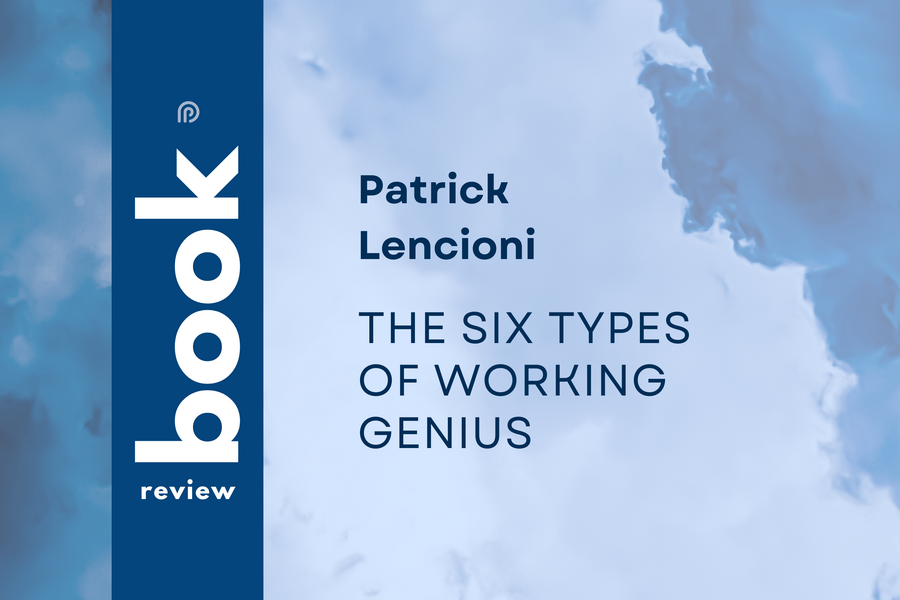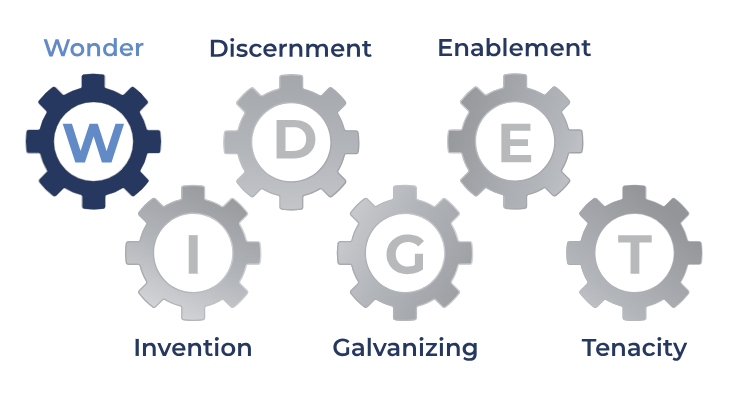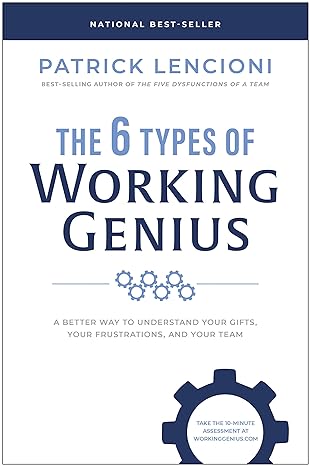
Patrick Lencioni’s book, “The Six Types of Working Genius,” aligns with the idea that individuals possess innate, God-given talents or geniuses that contribute to their effectiveness in the workplace. Recognising and understanding the six types of working genius, individuals and teams can strategically manage their efforts to capitalise on strengths, address frustrations, and cultivate a more effective and satisfying work environment.
Lencioni underscores two fundamental truths that form the cornerstone of his philosophy. Firstly, he emphasises the inherent satisfaction and success that individuals experience when they leverage their natural, God-given talents, highlighting the transformative power of aligning personal strengths with one’s work.
Secondly, Lencioni extends this principle to teams and organisations, suggesting that those fostering an environment where individuals can tap into their God-given talents are inherently more successful and productive.
This dual perspective underscores the interconnectedness of personal fulfillment and organisational success, forming a synergy between individual and collective talent utilisation.
Two Areas of Working Genius
Individuals have two specific areas, or geniuses, that are considered their gifts. These areas bring joy, energy, and passion into their work. This aligns with the belief in natural, God-given talents that contribute to a person’s fulfillment and effectiveness at work.
Two Areas of Working Frustration
Two of the six types are designated as Working Frustrations. These activities tend to drain individuals of joy and energy. Lencioni acknowledges that not everyone is skilled in these areas, highlighting the importance of recognising and understanding one’s limitations to optimise overall performance.
Two Areas of Working Competencies
The final two types are termed Working Competencies. These activities neither significantly feed nor drain individuals; they can be done reasonably well for a limited period. This recognises that there are tasks individuals can perform competently, but they may not provide the same level of fulfillment or passion.

Image credit: Patrick Lencioni, The 6 Types of Working Genius
The Six Types of Working Genius
Patrick Lencioni introduces a framework that categorises individuals into six working geniuses, highlighting two that come naturally and energise, two that are frustrating, and two that are neutral. Here are their definitions:
The Genius of Wonder
“The natural gift of pondering the possibility of greater potential and opportunity in a given situation… People with the Genius of Wonder naturally ponder the need for change in a given situation and can’t help but question why things shouldn’t or couldn’t be better.”
The Genius of Invention
“The natural gift of creating original and novel ideas and solutions… People with the Genius of Invention thrive on creativity. They are naturally drawn to coming up with ideas, seemingly out of nowhere, to solve the problems or address the needs that they or others identify.”
The Genius of Discernment
“The natural gift of intuitively and instinctively evaluating ideas and situations… People with the Genius of Discernment have a knack for instinctive, intuitive judgment and evaluation of ideas and options.”
The Genius of Galvanising
“The natural gift of rallying, inspiring and organising others to take action… People with the Genius of Galvanising bring energy and movement to an idea, project or function.”
The Genius of Enablement
“The natural gift of providing encouragement and assistance for an idea or project… People who have the Genius of Enablement (by the way, enablement is not a bad word at all, even if it’s often associated with people who support others in their dysfunctions or addictions) are naturally inclined to offer their enthusiastic support to a person who needs assistance with a project, function or idea.”
The Genius of Tenacity
“The natural gift of pushing projects or tasks to completion to achieve results… People with the Genius of Tenacity are all about execution, making sure that whatever they’re working on is accomplished and achieves the desired results.”
Key Takeaways
Lencioni’s model follows a natural workflow starting with Wonder and culminating in Tenacity. This progression reflects the idea that different types of genius contribute sequentially to the accomplishment of work, emphasising the importance of diversity and specialisation in a team.
Interdependence
The model highlights the interdependence of the six types of working geniuses. Each type gives and receives something from adjacent types, creating a comprehensive and natural workflow. This interconnectedness underscores the idea that a collaborative approach, leveraging diverse talents, is essential for the success of any endeavour.
The comprehensive process highlights the significance of not only recognising but actively leveraging and collaborating with the diverse types of working geniuses. This emphasis highlights the intrinsic value of diversity and specialisation.
By acknowledging and capitalising on the unique strengths and talents that each individual brings to the table, teams can forge a more dynamic and resilient path toward achieving goals.
In fostering collaboration among individuals with diverse working geniuses, organisations are able to unlock the potential for innovative problem-solving, creativity, and a more robust capacity to address challenges. The comprehensive process thus becomes a strategic roadmap, guiding teams toward success by harnessing the collective power of diverse talents and specialised skills.
Team Effectiveness
Lencioni offers valuable insights into enhancing team effectiveness through practical tools like “The Team Map,” a visual representation of collective geniuses and frustrations within a team. He highlights the critical connection between the six working geniuses and organisational health. Recognising and leveraging these geniuses are essential for team cohesion, productivity, employee retention, engagement, morale, and more effective meetings.
Self-Assessment
The book offers a self-assessment tool enabling individuals to identify their primary and secondary working geniuses. This tool facilitates a deeper understanding of one’s strengths, natural inclinations, and areas of frustration. It can be helpful to optimise individual performance, enhance collaboration, and contribute more effectively to teamwork.
Patrick Lencioni highlights the idea that teams and organisations require a balance of all six geniuses to accomplish tasks effectively. He suggests that individuals typically possess two primary geniuses, which bring them joy and energy, and two secondary geniuses, which they can perform competently but may find draining over time. Additionally, people often have two geniuses that frustrate them if they have to use them frequently.
At the heart of Lencioni’s argument is the essential alignment between individuals’ inherent strengths, referred to as geniuses, and the responsibilities associated with their roles.
He highlights the potential problem when individuals, after experiencing success in roles that leverage their geniuses, are promoted to positions that do not align with their strengths. While they may be competent in these roles, the mismatch can lead to exhaustion over time.
Understanding the individual working geniuses of team members offers substantial benefits for managers and HR practitioners. Firstly, it facilitates the alignment of individuals with tasks that best leverage their strengths, optimising performance. Secondly, it cultivates a culture of diversity and the utilisation of specialised skills, fostering engagement and a sense of belonging within the team.
This book explores critical issues, emphasising the strategic investment of organisations in maximising strengths, minimising weaknesses, and fostering collaboration.
One particularly impactful concept is the idea of shifting from traditional task-based job descriptions to designing roles aligned with individuals’ working geniuses.
In a task-based approach, job descriptions are often formulated around specific duties and tasks, focusing on what needs to be done. However, by aligning roles with individuals’ working geniuses—areas where they naturally excel and find joy or feel like themselves—organisations can tap into employees’ strengths, enhancing productivity and job satisfaction.
For HR, this shift offers opportunities for better talent acquisition by matching individuals with roles that align with their natural abilities. It can also improve employee retention as individuals are more likely to stay engaged and fulfilled in roles that leverage their strengths.
Lencioni’s Working Genius model encourages constructive dialogues between management and employees about strengths, weaknesses, preferences, contributions, and fulfillment at work, promoting trust and collaboration. It can serve as a valuable framework for team leaders to tap into the innate talents of each team member and enhance various aspects of work. It empowers team leaders to make well-informed decisions regarding their people, fostering a more productive, happy, and fulfilling work environment.
Patrick Lencioni’s book offers numerous insights into the success of individuals, teams and organisations. It is rich with lessons that warrant revisiting. As HR and organisational development practitioners, we found the book highly enjoyable, resonating with our professional experiences. We believe you will also find it interesting and thought-provoking.


If you need to develop your leadership capacity and team work, speak with our lead consultant on +44 (0) 7783 908571. We have delivered effective bespoke training and coaching programmes to over 6,000 leaders from 24 business sectors, helping them to achieve their goals.

